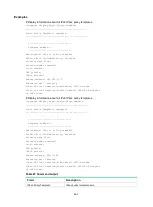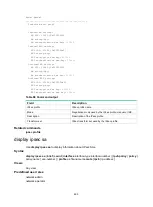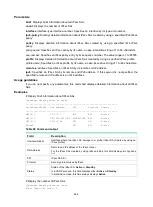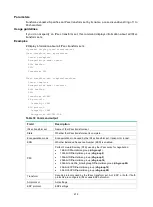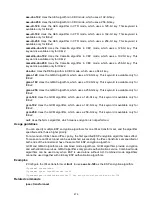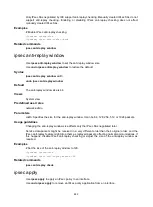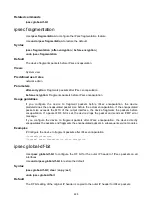
475
SA's SPI:
outbound: 6000 (0x00001770) [AH]
inbound: 5000 (0x00001388) [AH]
outbound: 8000 (0x00001f40) [ESP]
inbound: 7000 (0x00001b58) [ESP]
Tunnel:
local address: 1.2.3.1
remote address: 2.2.2.2
Flow:
as defined in ACL 3100
Table 74 Command output
Field
Description
Tunnel ID
IPsec ID, used to uniquely identify an IPsec tunnel.
Status
IPsec tunnel status:
Active
or
Standby
.
In a VSRP scenario, this field displays either
Active
or
Standby
.
In standalone mode, this field always displays
Active
.
Perfect Forward Secrecy
Perfect Forward Secrecy (PFS) used by the IPsec policy for negotiation:
•
768-bit Diffie-Hellman group (
dh-group1
)
•
1024-bit Diffie-Hellman group (
dh-group2
)
•
1536-bit Diffie-Hellman group (
dh-group5
)
•
2048-bit Diffie-Hellman group (
dh-group14
)
•
2048-bit and 256_bit subgroup Diffie-Hellman group (
dh-group24
)
•
256-bit ECP Diffie-Hellman group (
dh-group19
)
•
384-bit ECP Diffie-Hellman group (
dh-group20
)
SA's SPI
SPIs of the inbound and outbound SAs.
Tunnel
Local and remote addresses of the IPsec tunnel.
local address
Local end IP address of the IPsec tunnel.
remote address
Remote end IP address of the IPsec tunnel.
Flow
Information about the data flow protected by the IPsec tunnel, including
source IP address, destination IP address, source port, destination port,
and protocol.
as defined in ACL 3001
Range of data flow protected by the IPsec tunnel that is established
manually. This information shows that the IPsec tunnel protects all data
flows defined by ACL 3001.
encapsulation-mode
Use
encapsulation-mode
to set the encapsulation mode that the security protocol uses to
encapsulate IP packets.
Use
undo encapsulation-mode
to restore the default.
Syntax
encapsulation-mode
{
transport
|
tunnel
}
undo encapsulation-mode



